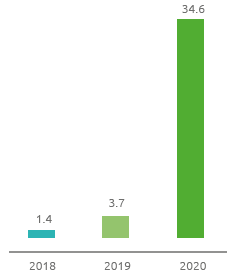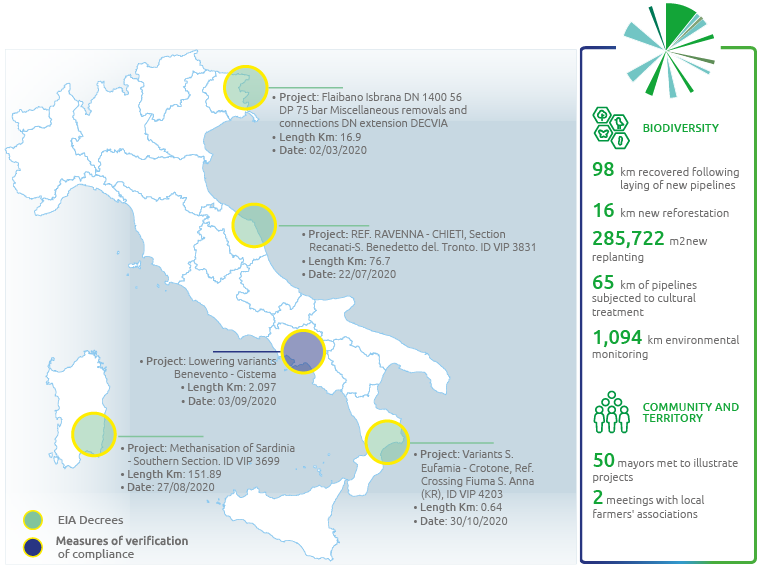Protection of biodiversity

In addition to reducing emissions, protecting the territory and biodiversity is one of the environmental challenges that must be addressed in order to create a sustainable development model. In fact, when building infrastructure, Snam pays great attention to the design and decommissioning of gas pipelines, in order to ensure that they are built with respect for the environment and the biodiversity of the areas on which they are built, adopting compensation practices where impacts are unavoidable.
Right from the network design phase, Snam undertakes to implement all the measures necessary to avoid or minimise the impacts associated with its works: where relevant, these are assessed in environmental and safety terms through Environmental Impact Assessments (EIA) or Integrated Environmental Authorisation (IEA), after which the competent Administrations, both at central and local level, issue the authorisations to start the activity.
In the design phase, the route is chosen from among several alternatives with the aim of avoiding or minimising the passage through areas of significant natural or cultural interest, archaeological areas, geologically unstable areas, anthropised areas or areas where new housing developments are planned.
In relation to the construction of the most important works (compression plants or large methane pipelines), Snam also assesses the direct and indirect economic-social impact on the territory and local communities with Social Impact Assessment tools and methods, through the adoption of a regionalised Input-Output model developed in collaboration with the Department of Economics and Management of the University of Brescia, which makes it possible to assess the impact of a project, calculating the added value generated by the investment from the total value of production.
Following the pipeline design and decommissioning phases, Snam initiates a series of operations aimed at restoring the pre-existing vegetation and morphological conditions, guaranteeing the stability and natural balance of the surrounding habitat and promoting the biological functionality of the area. In particular, to develop new infrastructure, Snam adopts procedures that meet stringent environmental compatibility and safety assessments and ensure maximum respect for the natural environment and protection of biodiversity. The Group’s approach involves a plan of at least five years of reforestation, care and maintenance of plants and shrubs, followed by a phase of environmental monitoring of the surrounding natural area, comparing conditions after restoration with the original ones.
The new ESG Scorecard has incorporated a new specific target for vegetation restoration in natural areas affected by the construction of the Group’s pipelines, which aims to ensure almost complete (>99%) restoration of the vegetation in question up to 2023, the progress of which will be available from 2021.
Four actions to protect the territory and biodiversity
When laying and decommissioning a pipeline, Snam is committed to protecting the territory and biodiversity by applying a process guided by four fundamental guidelines:
- Avoid damage to the environment and biodiversity in the areas where Snam’s infrastructure is located;
- Minimise impacts on landscapes and biodiversity;
- Restore pre-existing vegetation and morphological conditions;
- Compensate for any impacts with further action to safeguard and protect the environment.
In order to manage this process effectively, Snam relies on the collaboration of external partners when necessary to support it in managing the more specialised aspects.
| Download XLS (11 kB) |
|
2018 |
2019 |
2020 |
||
|---|---|---|---|---|---|
Restoration |
227 |
63 |
98 |
||
New reforestation * |
21 |
8 |
16 |
||
Environmental care |
74 |
73 |
65 |
||
Environmental monitoring |
445 |
747 |
1,094 |
||
|
|||||
Attention to safeguarding the territory and protecting biodiversity also continues in the phase of monitoring the proper functioning of the network, during which Snam acts on several fronts, ensuring complete, efficient and effective control of all its assets. Pipelines, storage facilities and ancillary plants are regularly inspected by specialist personnel either on foot, by vehicle, by helicopter or by drone. Snam is also committed to the study and development of new technologies, including some in the field of artificial intelligence, aimed at the continuous improvement of these activities. For example, the Group uses intelligent “pigs”, devices equipped with sensors that, as they pass through pipelines, detect the presence of any defects or anomalies in the material or smallest shifts in the pipeline or thanks to various In Line Inspection solutions, which are based on advanced devices capable of detecting deformations in the section of the pipeline, defects of a constructive or corrosive nature, but also shifts in the axis of the pipeline itself over time. Among the most recent developments is the study of the possibility of introducing satellite detection technologies to improve the ability to intercept potential activities dangerous to infrastructure security. In 2020, Snam launched the Leak Detection and Repair project, developed in-house, which consists of an aerial inspection and detection system capable of detecting any methane leaks. Specifically for storage plants, Snam instead monitors through detection systems that can activate the securing of plants (e.g. smoke detectors, pressure transmitters, etc.).
| Download XLS (11 kB) |
|
2018 |
2019 |
2020 |
|---|---|---|---|
Network inspected using smart pigs |
1,651 |
1,651 |
1,487 |
Network inspected by helicopter |
18,462 |
20,178 |
20,662 |
Network inspected with Leak Detection technology |
- |
- |
10,535 |
Network subject to geological inspection |
4,209 |
5,163 |
4,438 |
Distance covered by methane
pipelines in Natura 2000
networking sites (km)

Finally, Snam pays particular attention to operations involving Sites of Community Interest (SIC), Special Areas of Conservation (ZSC) and Special Protection Areas (ZPS), which together constitute the Natura 2000 Network Sites, the main instrument used by the European Union for the conservation of biodiversity established pursuant to the Habitats Directive 92/43/EEC to preserve natural habitats at EU level.
For 2020, the Natura 2000 Network Sites subject to infrastructure laying covered the following regions: Piedmont, Veneto, Emilia-Romagna, Tuscany, Apulia, Sicily and Republic of San Marino.
Decrees and measures obtained during the year
(by MATTM)
Enlarge image
| Download XLS (11 kB) |
Project |
Length (km) |
Regions involved |
Date submission |
|---|---|---|---|
Refurbishment Foligno (fraz. Colfiorito) – Gallese – and related works |
109 |
Marche. Umbria and Lazio |
06/03/2020 |
Recanati – Foligno extension of the EIA decree |
78 |
Marche and Umbria |
19/03/2020 |
Refurbishment Chieti-Rieti |
134.528 |
Abruzzo and Lazio |
07/04/2020 |
Refurbishment Gagliano-Termini Imerese Phase 2 |
60.45 |
Sicily |
09/04/2020 |
Refurbishment Sansepolcro-Terranuova Bracciolini and related works |
45.621 |
Tuscany |
27/07/2020 |
| Download XLS (11 kB) |
Project |
Length (km) |
Regions involved |
Date submission |
|---|---|---|---|
Methane pipelines Pisticci – Sant’Eufemia – implementation of works by dimensioning MOP 26 bar |
5.185 |
Calabria |
18/03/2020 |
Connection IVI Petrolifera Spa |
4.19 |
Sardinia |
10/04/2020 |
Adaptation of the Malborghetto Gas Compression Plant |
_ |
Friuli Venezia Giulia |
15/04/2020 |
Reduction system HPRS10 and Variant Met. Melizzano-Afragola DN 750 DP 75 BAR, in the municipality of Melizzano (BN) |
_ |
Campania |
01/06/2020 |
Variants for inspection Met Castelcampagnano – Caserta |
_ |
Campania |
22/07/2020 |
Preventive archaeology and archaeological discoveries in Sicily and Apulia
Snam has always considered it important to carry out its works while respecting and protecting cultural heritage, in particular the preservation of collective memory, which does not reside solely in monumental remains or in archaeological finds as such, but also in the stratified deposits that have not yet emerged from the ground, and therefore have not yet been identified. The organisational controls defined by the Group allow it to respond promptly to regulations which, in this field, are increasingly sensitive to environmental, natural and cultural aspects and require the application of new protection systems both at the design and construction stages. In order to ensure the protection of cultural heritage and the preservation of collective memory, and in compliance with regulations, Snam adopts a preventive archaeology approach, to reduce as much as possible the impact of the works in areas presumably at “archaeological risk”.
In particular, Snam, through a team in charge of archaeological monitoring of the area concerned, carries out an interdisciplinary analysis (morphological, geological, hydrographic, landscape, architectural, etc.), as well as in-depth bibliographic, archival and reconnaissance research to detect and preserve any finds and stratifications of historical and cultural interest.
In the context of the Group’s operations, archaeological monitoring is not limited to the design phases of the project, but is also carried out effectively and with equivalent levels of protection during the construction phase, also making use of the specialist contribution of an archaeological team that supervises all earth-moving operations, dealing promptly with any emergencies and sharing with the competent Superintendency the progress of the work, the results of investigations and the necessary in-depth studies.

An example of the effectiveness of this process was seen between May and September 2020, in Caltavuturo, Sicily, when studies for the design of the Gagliano-Termini Imerese methane pipeline brought to light a section of the ancient Roman road Catina-Thermae, datable, thanks to the materials found, to the 2nd-3rd century AD (late imperial age). This discovery is of focal importance as it is the first section of Roman road ever found on Sicilian soil. Already known from ancient sources (Itinerarium Antonini and Tabula Peutingeriana) and hypothesised there by scholars of ancient typography, the road was one of the main Roman arteries which, joining the cities of Catania and Termini Imerese, served as a commercial and military link between the Ionian and Tyrrhenian Seas.

Again, in 2020, during the construction of the TAP Interconnection pipeline, archaeological surveillance activities in Torchiarolo (BR) allowed the identification of a nucleus of buried masonry structures forming part of numerous domestic and artisan environments. The investigated area was also subjected to a geoscanner survey and non-invasive magnetic prospection outside the working strip in order to further clarify its general layout and extension. Based on the results obtained, it was determined that the entire area constitutes a vast archaeological site, which will be the subject of subsequent excavations by the Superintendence of Brindisi, Lecce and Taranto. To date, the interpretation of the nature and dating of the site is still being worked out.